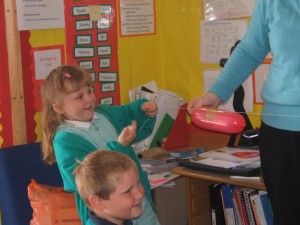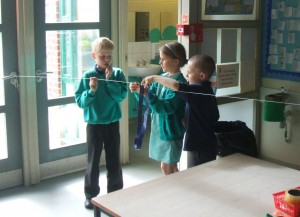Students at the Blanford St. Mary’s School in the UK put the Scientific Method to work.
A morning with balloons flying across your room is always a great way to start the day. This is why year 2 students at the Blanford St. Mary’s School in The United Kingdom were challenged by their teachers Rosemary Rees and Sarah Thornton to answer a science question that was part of our Balloon Rocket experiment. (see link below) They were asked, “Does the shape of the balloon affect the distance the rocket travels?” This became a great way to bring the SCIENTIFIC METHOD to life in the classroom.
The scientific method is an organized way to answer a science question. First, students discussed their thoughts based on the knowledge that they had gained from using balloons of different shapes in the past. For some, this lead to a hypothesis – an answer to their science question based on what they know.
They then came up with a way to test their hypothesis a experiment. (This is the fun part!) The students set up a balloon rocket course in the classroom and began testing out the balloons. They tested round balloons and narrow balloons, being sure to use the same amount of air in each. They measured after each flight and kept notes on each distance. After all the balloon flying, they got to the final step. They looked at all the data from the experiment to figure out if their hypothesis was correct. So which kind of balloon traveled the farthest? Why not try it our yourself, or if you just can’t wait, visit their blog to find out the answer.